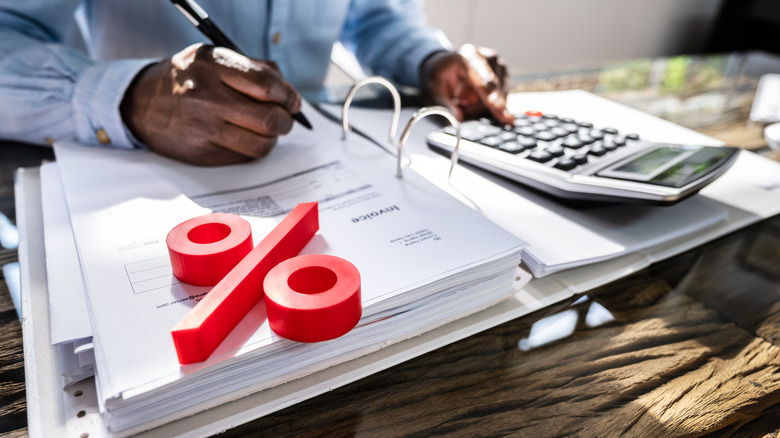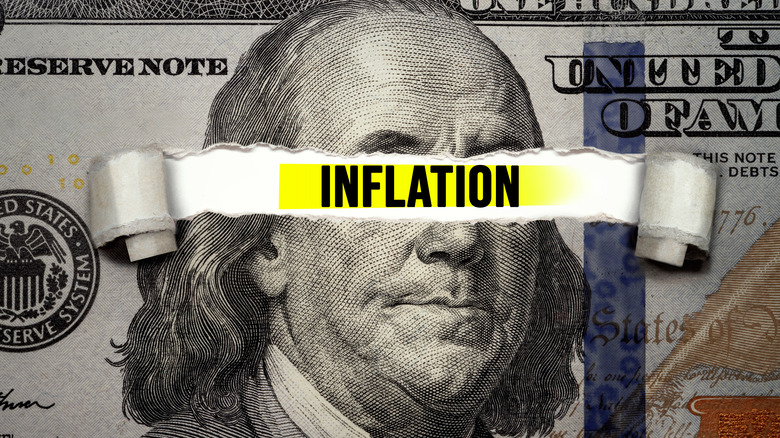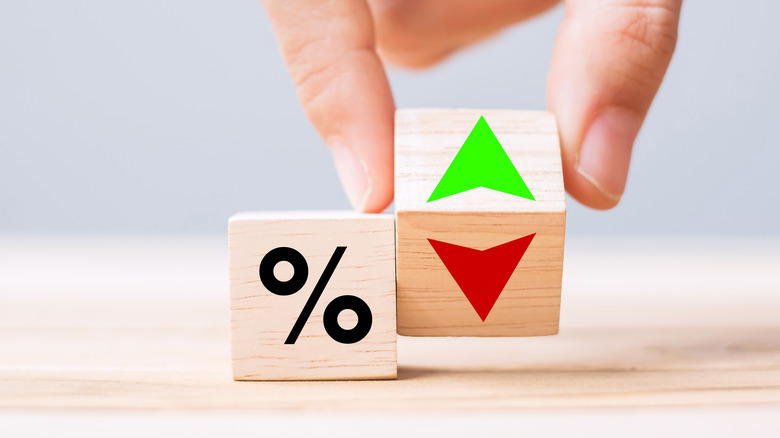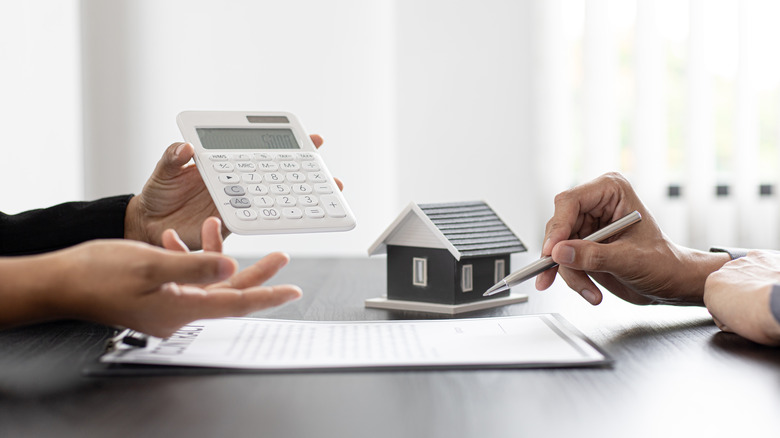What Is APR In Real Estate?
APR is a common term in the financial world, but it's also one that many borrowers misunderstand. APR stands for annual percentage rate and acts as the actual yearly cost of borrowing over the course of a given year (via Investopedia). APR is often thought of interchangeably with the base interest rate that a borrower accrues on their debts, however, making this miscalculation when it comes to your finances can be a costly mistake.
According to Statista, 94% of all 2021 home sales in the United States were financed with the help of a mortgage loan of some type (a trend that has prevailed in recent years, with annual figures of 96.5% in 2020, 93.9% in 2019, and 93.7% in 2018). This means that as a first-time buyer, you will probably rely on borrowed capital when moving into your new home. Understanding the potential value and risks associated with borrowing is something that all home buyers must focus on in order to maintain fiscal stability and a comfortable life moving forward.
Even though financial data can feel unapproachable at first, the truth is that APR and many of its related concepts are actually quite easy to dig into.
The basics of APR and interest
The annual percentage rate is an aggregate total of the stated interest rate, which forms the basis of your lending agreement, and any other costs that factor into that arrangement. These can be closing costs, origination fees, and any sort of yearly fees, taxes, or insurance add-ons. In the real estate space, there are many additions that play a role in the final tally of the overall repayable sum.
Interest and APR rates make the borrowing process clearer
Bank of America reports that APR figures are intended to give consumers a broader understanding of the financial agreement surrounding any loan. APR provides clarity to borrowers because it includes both the cost of the loan and any additional fees. One great example is the annual fee charged to credit card holders. Rewards cards that provide cash back or travel points often incorporate additional benefits that entice users to pull out this piece of plastic over another (especially considering that the average U.S. cardholder maintains four credit accounts, via CNBC). But, in return for these additional perks, cardholders are often charged an annual fee, which is estimated by the U.S. News & World Report to average around $110 per year.
On a card that charges an annual fee, the discrepancy between the interest rate and the APR can be vast. In this case, the APR rate often provides a more accurate figure than a specific interest rate addition: A timely reminder for consumers who might otherwise gloss over the finer points of a credit agreement.
APR and interest calculations help motivate borrowers to pay back their loans
On a more basic level, calculating repayment obligations with the interest and APR figures in mind helps borrowers understand the additional costs linked to the principal borrowed. On a home, automotive, or personal loan, the borrowed figure comes as a lump sum from the creditor. This means that interest is added to the entire balance from the funding date, and the addition of interest is assessed against money borrowed rather than the total available.
As a result, borrowers can calculate exactly how much they will owe at any given point in time. The U.S. News & World Report (and many other leading financial outlets) highly recommends using a mortgage calculation tool to manage your finances in real-time, while keeping consistent track of owed balances and assessed interest additions. Knowing how much you owe and what the cost of this funding will be in any given year can act as a great motivator to reduce the overall balance and eliminate debts with haste.
Interest works both for and against consumers
Interest rates are everywhere in the financial world. Consumers enjoy interest earnings on their savings accounts and other investment products. But they also pay interest on borrowed cash. According to the Federal Reserve Bank of New York, American household debt rose in the fourth quarter of 2021 to $15.58 trillion, while mortgage debt rose by $258 billion alone. Conversely, the very best APY rates (annual percentage yield) on savings accounts still barely scratch the 1% threshold (via Bankrate).
The stated interest rate acts as the foundation for APR
Interest rates form the basis for APR, and as a result, make up perhaps the most important component of the calculation. The interest rate you pay on any borrowed money acts as a guide for the overall cost. It can be helpful to think of the interest as a type of fee for borrowing money (Khan Academy offers a helpful primer on this mental financial framework). For instance, a $100,000 loan that includes a yearly interest rate of 5% will cost you $5,000 per year, or a part of that in proportion to the remaining balance on a rolling basis. It's helpful to reimagine consumer debt in this light because it reframes the borrowing experience and can help you make better sense of your purchasing and borrowing decisions.
Likewise, when you invest in a savings account or CD, the bank pays you interest as an incentive to lend them cash. However, it's important to remember the gulf that exists between interest rates and APR on capital that you borrowed versus cash you've lent out as a consumer. As of April 20, 2022, average credit card interest rates have shrunk for the first time in months to a figure of 16.36% (via creditcards.com). This is great news for consumers who use credit cards in their daily spending but does little to alleviate the discrepancy between incoming and outgoing interest.
Real estate operates in a different atmosphere
Real estate is somewhat different from other elements of consumer credit. There are more than one billion credit cards in circulation in the United States, which is three times more than the number of American debit cards (via Statista). But with some of the highest interest rates attached to credit card borrowing, these accounts should be used sparingly. In contrast, mortgage loans provide some of the most cost-effective funding available to consumers.
Homeowners who are trying to develop greater financial mobility often target real estate opportunities as a means to create wealth (via Forbes). Property investors love the ability to lean on mortgage lenders, and homeowners have a wealth of opportunities available to them in the form of home equity loans, HELOC financing, and of course the ability to sell a home as its value rises over the long term.
Buying a home involves the use of incredible leverage
One primary difference in the real estate space is the vast amount of leverage available to buyers. When purchasing a home, it's common to put down 20% or less out of your savings on the total cost of the property. According to The Motley Fool, home buying trends across the country range dramatically with the median down payment coming out at just $27,850 in June 2021. This indicates that a typical down payment is around 10%, meaning that homebuyers can take advantage of this massive leverage factor when purchasing real estate.
Leverage exists in some form in virtually every commodity market
The truth is that investors are often able to take advantage of leveraged purchasing. Many investment platforms that deal in stocks, options, forex, and cryptocurrencies now incorporate leverage as a standard practice to help investors earn additional profits. However, this ability to borrow to increase portfolio profitability is highly regulated and is usually capped at 50%, or further minimized by some brokerage account providers (via Investopedia).
This means that while real estate is often one of the most profitable investments that can be made, and offers the best leverage opportunity on the market, it's important to note that any investment — whether in real estate or other marketplaces — is marked by some degree of risk. Using leverage to enter into a new trade magnifies this risk: While profits are multiplied by the added capital, so too are the losses (via The Balance).
A home is an investment in more ways than one
A home is perhaps the ultimate investment. Owning your own home is the aspiration of countless Americans, as represented in a Pew Research Center study that showed near-record home buying statistics in the final months of 2020. Owning a home provides stability to consumers who are often able to minimize routine outgoing expenses with an affordable mortgage.
Homeownership offers price protection in uncertain markets
APR figures surrounding mortgage loans can provide price protection to new homeowners who've just left the rental marketplace. One way that property investment can pay immediate dividends is with the help of a fixed-rate mortgage, which will ensure equal repayment throughout the entire term period (via Rocket Mortgage). Rather than dealing with rising rental costs, moving into your own property can actually reduce monthly payments. Additionally, instead of paying a landlord for the privilege of living in their property, you'll be building equity in a commodity that you own and can be used as a financial instrument in the future.
Borrowing against your property can unlock financing for the future
With a secured personal loan or a home equity line of credit, using the equity in your home to finance renovations or other major expenses can streamline your overall financial picture. Home equity loans, including HELOCs and second mortgages, are great for homeowners seeking an infusion of cash while circumventing the typically steep APR rates that come along with traditional personal loans — ranging from 6% to 36% and averaging at 9.41% (via Experian). In contrast, the national average for a home refinancing rests at 5.06%, according to Bankrate.
Investors often use the property market to develop greater net worth
Property investors will cite all of these factors when considering real estate opportunities. Owning a home is a great way to shore up the fiscal balance through tax incentives and other inherent benefits (via Investopedia). By making investments in the property market that go beyond your own personal abode, you can also capitalize on both rising rent costs and a nearly perpetual appreciation of the asset's underlying value, according to the Federal Reserve Bank of St. Louis.
Interest rates and APR calculations can make or break a budget
For both real estate investors and traditional homeowners who aren't thinking of their home in terms of investment positioning, the APR calculation can make for a healthy cash flow or one that eventually sinks your family's fortunes.
Interest rates can easily cause debts to pile up
Borrowing money has become a natural part of modern life. It's easy for a borrower to become overextended while making use of credit cards and personal financing opportunities. Minimum payments can make this problem all the more difficult to manage. Experian recommends covering the minimum payment and then adding as much additional cash to your monthly repayments as you can realistically afford.
Covering the minimum payments owed on each of your credit accounts is important of course, but only paying out this minimal amount each month is the fastest way to grow your overall debt burden rather than cut it down. CNBC reports that Americans utilized an average total credit limit of $22,751 across their combined accounts in 2019. While this can certainly open up purchasing opportunities, it also provides a clear and hazardous blueprint for falling into debt. Carrying balances over from one statement period to the next increases pressure on a consumer's cash flow and general financial health. Therefore, making sense of the APR on a new credit line or personal loan is a vital element in understanding whether a new financing opportunity will lead to a boon or bust.
A healthy understanding of smart debt balancing can make borrowing highly profitable
With the ability to borrow additional sums of money, opportunities exist everywhere in the real estate market. Instead of waiting until you've amassed 50% of a home's purchase price, lenders make it easy to get into the market for qualified buyers who have shown both responsibilities with borrowed capital and a dedication to personal savings.
Consider, for instance, purchasing a $100,000 home in cash versus the same buying opportunity with a 10% down payment. A saver who can set aside a $10,000 down payment in just a year would have to spend nine additional years saving just to build the funds required to invest in the property's current value. But this simple math doesn't take into account the yearly price appreciation over that 10-year period, boosting the total cost to $157,300, (based on the Freddie Mac House Price Appreciation Index, via Statista).
Over the same stretch, a buyer who secured available funding would have been able to invest in the home for a nominal down payment of $10,000 (plus any closing costs and associated fees that are bundled into the APR figure). Without considering mortgage insurance and tax costs, the buyer would be responsible for a recurring monthly payment of just $566.47 (based on a fixed-rate 30-year term and calculations from mortgagecalculator.org). All of this results in a total expense of just under $78,000, an investment value increase of more than 50% and the remaining $22,000 successfully tucked away in a savings or retirement account.
APR is a means of defining the total costs associated with borrowing capital
In the world of real estate, this APR rate is particularly useful due to the additional financial considerations that make their way into the finalization of a mortgage loan.
In other aspects of personal finance, the APR figure and interest rate often come out as the same value (via CNBC). However, in the property market, and in many other forms of consumer debt, these calculations can be miles apart. Understanding the true cost of any borrowed capital is the first step in the intelligent decision-making process of homeownership, consumer purchasing, and saving plans. Make sure you're knowledgeable about the calculation of APR figures, as these will dominate your repayment schedule and the financial future of you and your family.





